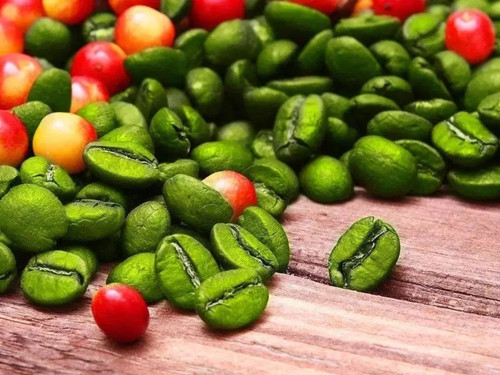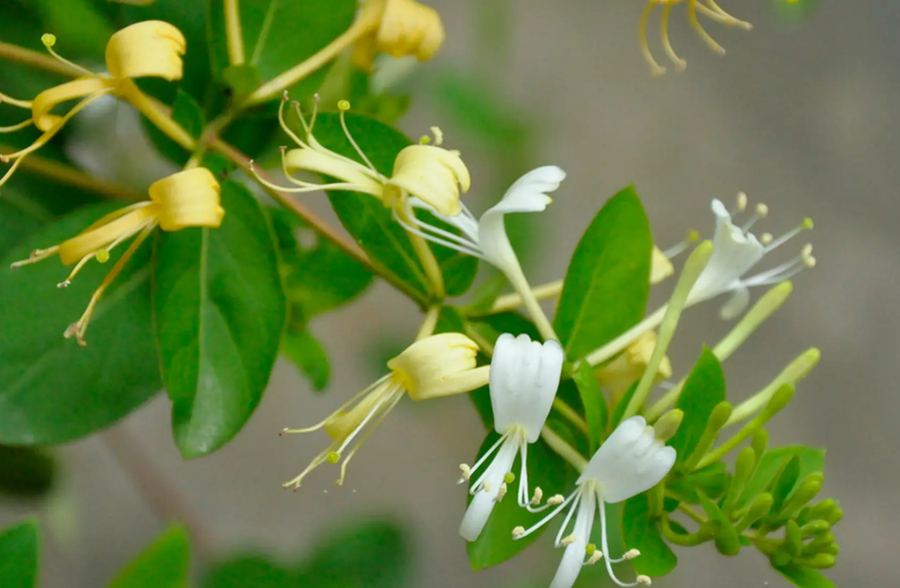Chlorogenic acid is 5-0-Caffeic quinic acid, also known as caffetannic acid, which is a phenolic acid produced by caffeic acid and quinic acid or by shikimic acid in plants during aerobic respiration. Chlorogenic acid is widely found in higher dicotyledons and ferns such as Lonicera and Artemisia family such as sunflower seeds, tea, soybeans, wheat, cocoa beans, coffee beans and some Chinese herbs, especially cocoa beans, coffee beans and some traditional Chinese herbs, including honeysuckle, eucommia ulmoides, etc. It also occurs naturally in some fruits and vegetables, including apples, carrots, beets, grapes, pears, blueberries and strawberries. Although the scientific research behind the effectiveness of chlorogenic acid is still limited, the natural food source of this powerful antioxidant may be the perfect supplement to meet your needs. Here we will introduce some main natural sources of Chlorogenic Acid.
Chlorogenic Acid in Green Coffee

Green Coffee Bean
Green coffee beans contain a significant amount of chlorogenic acid. Green coffee bean extract is the most common supplement form for chlorogenic acid. This ingredient may have a wide range of health benefits and can improve your mood and lower your blood pressure.
A clinical trial on 52 people found that chlorogenic acid-rich coffee reduced weight and other risk factors for heart disease. Additionally, it reduced blood fat levels in individuals with high levels of “bad” LDL cholesterol. Likewise, two clinical trials involving 120 overweight individuals showed that chlorogenic acid-rich supplements reduced the BMI and fastieucommia ulmoidesng blood sugar of obese individuals with impaired glucose tolerance. In addition, chlorogenic acid-rich coffee extract significantly reduced the amount of body fat in individuals with metabolic syndrome and insulin resistance.
Taking green coffee bean extract may cause side effects if used in large doses. Some studies show that green coffee bean extract may increase the risk of asthma attacks, and it contains caffeine. Nevertheless, it may also interfere with sleep, so you should be aware of this possibility before consuming this supplement.
Chlorogenic Acid in Eucommia Ulmoides
A special ingredient in Eucommia ulmoides, chlorogenic acid, promotes the synthesis and degradation of collagen proteins. This compound promotes metabolism and can prevent the decline of bone and muscle tissues. It also has anti-free radical properties. However, it’s important to note that not all of these effects are attributed to chlorogenic acid. To date, studies have revealed that the chlorogenic acid content of Eucommia ulmoides has been widely studied.
Chlorogenic acid in Eucommia ulmoides contains antioxidant activity. It inhibits a transparent enzyme called glucose -6 phosphatase. In addition, it protects the liver and gallbladder from oxidative damage. Several researches show that chlorogenic acid has anti-tumor effects and can also lower blood lipid levels.
The antioxidant activity of chlorogenic acid has made it a popular ingredient in many cosmetic products. It prevents the formation of free radicals and helps to prevent the damage caused by ultraviolet rays. In fact, eucommia extract has many uses in pharmaceutical and cosmetics. Its polyphenol content makes it suitable for use in anti-bacterial and skin sunscreen products.
Chlorogenic Acid in Honeysuckle
Honeysuckle(Lonicera japonica) is considered as an ancient medicinal plant in China and has been studied for its chlorogenic acid content. Chlorogenic acid in honeysuckle is present in the leaves and flower buds. Phytochemical analysis of the chlorogenic acid in honeysuckle has shown that this compound has anti-inflammatory, antipyretic, antimutagenic, and even cancer-fighting properties. Despite these positive effects, its bioavailability remains a problem. Honeysuckle plants contain a vast array of phytochemicals, making analysis difficult.
The chlorogenic acid concentration in flower buds of honeysuckle was found higher than in the leaves, indicating that the flower buds contain a higher concentration than the leaves. These findings also suggest that honeysuckle flower buds may be more effective as a medical remedy than the leaves. The metabolomic impact of chlorogenic acid in honeysuckle is based on the concentration of the hydroxycinnamoyl-CoA-quaternary compound. This molecule causes the transcription of PAL1 and PAL2 gene family members. A study conducted on honeysuckle revealed a positive influence on the transcription of HQT and PAL genes in the human kidney, suggesting that the plant has anti-apoptotic effects.
Chlorogenic Acid in Tea
It found that 4.5 grams of Yerba Mate Tea contained about 72 milligrams of chlorogenic acid, compared with 9.12 milligrams per gram of green Tea (solid). Considering the loss after brewing with heated water, we believe that the chlorogenic acid content in green tea is far less than that in Mate tea. Recent studies have demonstrated the beneficial effects of chlorogenic acid on obesity and other metabolic disorders. In addition, this compound has been shown to inhibit the release of glucose-6-phosphatase, which may help balance blood sugar levels in diabetics. This study is important because chlorogenic acid is present in more than 60 percent of tea.
It’s healthy for those people taking tea. Studies have shown that consumption of 100 mg of chlorogenic acid before a meal significantly reduced plasma glucose and AUC. One study used a placebo group and gave the subjects 200 mg of (-)-epicatechin (15 min before the OGTT), as well as a placebo drink. One study showed that chlorogenic acid, when combined with a protein-resveratrol-containing diet, significantly reduced blood glucose and SBP.
The results of the study also suggest that chlorogenic acid inhibits the growth of fatty livers and can help prevent the development of hypertension. However, further research is needed to assess whether chlorogenic acid is truly an effective anti-oxidant. Currently, chlorogenic acid is used to combat metabolic syndrome in people. But this isn’t enough to claim its benefits. It needs to be proven that it works, and this is why it is being studied extensively in the world.
- Dandelion Extract: What It Is, Benefits, Uses and Side Effect - April 23, 2024
- Is Berberine Extract Help For Weight Loss? - April 11, 2024
- Why Is Pysllium Husk Powder A Popular Meal Replacement Ingredient? - April 3, 2024



